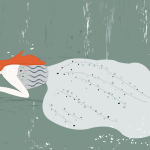
“I’ve missed more than 9,000 shots in my career. I’ve lost almost 300 games. Twenty-six times I’ve been trusted to take the game-winning shot and missed. I’ve failed over and over and over again in my life. And that is why I succeed.” ~Micheal Jordan
I believe that self-soothing is the key to accessing all happiness and success. All things being equal, when someone is able to self-soothe, they are more resourceful and more powerful than those who haven’t learned that skill yet. Here’s why.
Great success (whether professional or personal) comes with a great deal of responsibility. That responsibility can potentially lead to stress and is often accompanied by failures along the way. Most of us are familiar with that famous Michael Jordan quote—it was even in a ’90s commercial.
Resilience is a great skill. In fact, that path is clearly recognizable to anyone who has achieved a lot. But it’s perspective that shows you that those failures aren’t “this is the end of everything and we’re all going to die” failures. Instead, they’re just medium or even small-sized stumbling blocks.
When you’re not yet at the end of your career or life, how do you know? Well, you don’t. So how can you function when things don’t go your way? How do you stay calm and grounded when something unexpected and shocking happens?
The more “monodimensional” action-oriented side of resilience is to “power through” the hard times, sharpening your blade with your teeth. And while this might work sometimes, it takes a toll on your emotional well-being—can you feel that cortisol going through the roof?
It’s easy to miss that monodimensional, action-based resilience is actually very weak, and ultimately unsustainable, if it’s not supported by a strong and playful mind. And I believe that Jordan had such a mind and demonstrated it throughout his career.
It’s not just persisting despite failures; it’s also how you feel every day, about your failures and in general. It’s about not allowing all the negative experiences to poison your daily well-being.
So how do you make resilience more sustainable? There is a softer way to deal with stumbling blocks, one that hopefully doesn’t lead to too much stress or burnout. One that, when mastered, will keep the emotional well-being floodgates open.
One that you will want to teach to your friends, your kids, your parents, and your enemies too. This second dimension of resilience is self-soothing.
I was raised in the household of Ms. and Mr. Stress. Growing up, I watched them take deep dives into (probably unnecessary) pools of stress. There was always something that wasn’t okay, something that needed to be fixed, not enough money or not enough time.
Here’s a classic scene from my youth: When a piece of equipment, like the washing machine, would break, our whole family had to be part of the sorrow, anger, and anxiety associated with such an unfortunate event. But it wouldn’t be fixed right away (because it might… heal by itself, no?) When it would be absolutely clear that there was no hope for the poor washer, the focus would switch to panicking about the money needed to replace it.
Once the washing machine was replaced, the problem became that perhaps it won’t be as good as the previous one, or it might take up more space, or it’s louder. It was never possible to relax, for fear that everything wasn’t perfect. It was obligatory to look for potential problems, scanning every single detail with “Terminator vision.”
When we could finally be certain that everything was okay, we could then move onto the next thing that needed to be fixed.
I was exposed to chronic stress for most of my childhood and teenage years. I didn’t enjoy the environment, but I didn’t know why. I didn’t have words for it, and I didn’t have the concepts to understand it. I didn’t know that I could live differently. Or better yet, I knew other parents were more relaxed, but I just thought they were luckier individuals.
When I moved out, aged twenty-two, I left the country and moved to Holland, to a tiny student city whose pretty canals were filled with swans and ducks, and where most family houses had cute and well-groomed front yards. I watched kids on tiny bikes ride with their parents to school, and people of all ages sit for coffee in wooden decorated cafes. It was nothing like the stress-filled metropolis I was used to, and people seemed to me to be so calm.
I loved it instantly, and I felt the well-being flood me, but I didn’t know why. Over the course of the following years, I lived in other places too. For some segments of my life, I even went back to my childhood home.
It wasn’t until ten years after I first moved out that I was able to finally learn the names and the concepts that defined the emotional dichotomy I kept experiencing when I would go back and forth.
The understanding came in two steps. During my masters, when studying the brain, I learned how the pre-frontal cortex works as a simulator of experiences. We all, as humans, are capable of imagining in great detail something that hasn’t yet happened and make it just as real as something that happened the day before.
From psychologist Dan Gilbert, I learned that the brain is also capable of synthesizing happiness (or the cocktail of chemicals that we interpret as happiness). And a functioning brain will return you to a state of happiness withinmonths or within a year even after very traumatic events.
In a fascinating TED talk (The Surprising Science of Happiness), Gilbert presents data from two groups of people: people who won the lottery and people who lost the use of their legs. One year after the event, the level of happiness of the two groups is identical.
Very often, we hear people (or even our own selves) say how, with hindsight, some terrible event has revealed itself to be a kind of bliss. The bottom line is that it doesn’t matter what the cause of happiness was; if it feels like happiness, it is happiness.
The brain is capable of synthesizing happiness (or sadness, or stress, or panic, or even anger, for that matter) independently of the external conditions. This is not surprising. If you think about it, what we attempt to achieve through meditation is nothing but a firmer hold on the steadiness of the brain, which will then lead us (or keep us) in homeostasis, a state of physical balance. This is why meditation feels good, and also why it can be so hard to start meditating when your mind is all over the place if you don’t let yourself ease into it.
Once I grasped these concepts, I made my first leap into understanding emotional well-being. I saw people like my parents constantly training their minds to see faults and problems, rehearsing negative feelings, and therefore leaving completely to chance their effectiveness at reacting to more significant issues.
The second leap happened a few years later. I was done with my studies and was anxiously juggling the various areas of my life.
Over the course of less than a year, I lost my job in academia. I didn’t manage to get a new one (failure one). I got kicked out of a house where I loved to live (failure two) by a person whom I considered a friend (failure three). The man I had a relationship with left to be someone else (failure four), and I injured myself in such a way that was unable to use my right arm for months (failure five). Forget typing—how was I going to apply to new jobs?
As soon as I could, I packed my stuff, moved back with my parents to be taken care of, and got the final part of the treatment for my arm.
This setback happened when I was thirty-three to thirty-four. After the first months feeling loss and mourning for my previous life, I realized I wasn’t making it easy for myself. I was lingering in anger, obsessing over every small thing that wasn’t just right, and being devastated by all the big ones that weren’t right at all.
Then it clicked. My situation was no different than worrying about broken domestic appliances, stressing over taxes, feeling insulted by bad books or movies, getting annoyed by politicians and by lost socks.
I had to make it easier for myself. I had to find the irony in everything and spend more time thinking about what was working.
I wanted to “detox” from the victim mentality. I started looking at my life as the blankest of slates. And felt exhilarated.
In fact, my life was even better than a blank slate. I had all my skills, my knowledge, and my health. I had no ties, no debt, no contracts, and no furniture stored somewhere. Ultimately, I had a very supportive family and a place to stay temporarily in Rome, one of the most beautiful cities in the world.
Today, this list of positives is easy to make and I could go on. Now it’s easy for me to see how previously I had made myself more miserable, focusing on all that was going wrong. But I can still vividly remember how overwhelming it all felt and how it seemed impossible to stop that snowball from rolling down and becoming more bitter.
From my new place of clarity, balance, and bliss, I decided I’d devise tricks to prevent myself from ever tumbling down into deep negativity again. If I took care of how I felt every day and developed practical techniques to deflect my attention from the small daily problems, maybe I’d develop enough of a muscle that I could use if and when big problems occurred.
So I took a “masterclass in myself.” I learned what it is that makes me laugh, what grabs my attention, what relaxes me. Knowing these things will help anyone to stop that negative snowball before it hijacks your thoughts completely.
I have a great passion for comedy, and I figured out that, regardless of my mental state, listening to my favorite comedian will reset my mood 100% of the time. I know that nature documentaries (especially those about Space) will hypnotize me and make me slightly detached from my body, so when I’m sick or in pain, these are my go-to’s. I know that when I feel flustered or my mind feels scattered, walking and listening to certain music will bring me closer to calm.
Coming up with a list of ready-to-use resources like these ones, but tailored for you, is one of the greatest resources a person can have. And the more these resources are on autopilot, the easier juggling your life will become. For me, today, listening to comedy when I’m annoyed is as natural as drinking water if I’m thirsty. And every day, I’m still adding new practices to my arsenal.
There are two caveats to all this: Be aware of the cause of what makes you feel bad and watch out for escapism.
If you’re chronically depressed, I would never recommend watching comedy from morning until bed. If you have recurring anger issues, I wouldn’t recommend pumping them away at the gym. You need to seek professional help. Similarly, finding things that cheer you up is great, yet spending your whole day seeking ways to entertain yourself might not be the most constructive way to go about your life.
Self-regulation is one of those responsibilities that adults have, and it’s a great one to embrace. A rule of thumb is: If you’re still enjoying whatever it is you are self-soothing with, then great. If you’re neutral about it, it’s time to move on. And if you realize you’re not enjoying other things that you could have been enjoying, then your self-soothing has gotten out of hand. Don’t beat yourself up though; next time you’ll do better.
Generally, though, all it takes is to distract yourself sufficiently from the negative thought/memory of the event. Some other time you might want to consolidate some positivity to that memory. There are many ways (from NLP techniques to meditation techniques to hypnosis, and more), but for simple daily life, what I found works well for me is this three-step process:
1) Allowing some time for my immediate reaction to express itself. I don’t want to suppress anything, but I don’t want that state of reaction to be the place where I now reside.
2) I’ll go ahead with my self-soothing technique of choice and try to reduce the amount of time that my mind broadcasts thoughts about the problem.
3) After a little time has passed, I’ll pick up the topic and briefly discuss it with a trusted friend. Someone who doesn’t have any stake in it, who won’t be triggered by it, and who can provide both constructive and positive comments.
If you master a basic self-soothing practice, you’ll notice an immediate improvement in how you can handle the small daily hiccups. And with a little time (really not much time at all), you’ll be able to handle bigger and more complex problems with a lot less effort.
What’s wonderful about this skill is that it will continue to grow with you. As you add more pieces from your personal growth journey, they’ll strengthen this new skill as well.
A strong self-soothing practice will enable you to help and be compassionate with the people around you. It will also trickle down to your kids, providing them with one of the greatest resources they can receive from you.
About Marta Castella
Marta Castella is an accomplished linguist and educator with a Ph.D. in Formal Linguistics. She has dedicated her career to enhancing early education and promoting multilingualism, designing bilingual immersion programs and customized learning plans for young children, integrating mindfulness, cooking, gardening, and music. Marta's professional journey includes roles as a Natural Language Analyst, AI training and prompt design. When not immersed in research or teaching, Marta enjoys practicing sports and meditation.













 Though I run this site, it is not mine. It's ours. It's not about me. It's about us. Your stories and your wisdom are just as meaningful as mine.
Though I run this site, it is not mine. It's ours. It's not about me. It's about us. Your stories and your wisdom are just as meaningful as mine. 